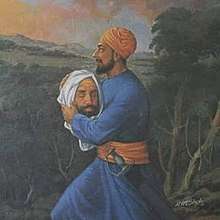Bhai Jiwan Singh
Baba Jiwan Singh (also called Bhai Jaita before baptism), a Mazhabi Sikh General and companion of Guru Gobind Singh.
Baba Jiwan Singh | |
|---|---|
 | |
| Born | 30 November 1649 Patna, India |
| Died | 7 December 1704 (aged 55) |
| Parent(s) | Sada Nand Mata Premo |
| Part of a series on |
| Sikhism |
|---|
 |
|
|
Practices
|
|
|
General topics
|
As well as his military prowess, he was a poet and a warrior. He also taught gatka, shabad kirtan, archery, horse riding, and swimming to Ajit Singh and Jujhar Singh, sons of Guru Gobind Singh.
Early life
Jaita was born in 1649 at Patna, Bihar (India) in a Mazhabi Sikh family to Sada Nand and mother, Mata Premo. He grew up at Patna where he got training in various weapons and learned the art of warfare. In addition, he learned horse-riding, swimming, music and Kirtan.[2] When Sikh families staying at Patna returned to Punjab Bhai Jaita and his family went to Ramdas village and lived with Bhai Gurditta, the great grandson of Baba Buddha. Later, Jaita got married to Bibi Raj Kaur, daughter of Surjan Singh.[3]
When Guru Tegh Bahadur, the ninth guru of Sikh, was martyred by the Mughals at Chandni Chowk, Delhi, Singh along with two other Mazhabi Sikhs, recovered his dismembered body from a Muslim crowd and brought it back to his son, Guru Gobind Singh.
There after Guru Gobind honoured them with the title Mazhabi ("faithful")[4] and said loudly, "Rangrete Guru Ke Bete"(The Rangretas are the Guru’s sons) to the all Mazhabi Sikhs. After that, Singh was instructed by his father to behead him in order to swap the head of his father for that of Guru Tegh Bahadur. Bhai Jiwan Singh carries out his father’s wish and carried the head of Guru Tegh Bahadur from Delhi to Gobind Rai in Anandpur Sahib.[5][6]
Battles and Death
Singh was with the Guru during the evacuation of Anandpur Sahib[7] and fought the battles of Bhangani, Nadaun, Anandpur Sahib, Bajrur, Nirmohgarh, all four wars of Anandpur Sahib, Bansali/Kalmot and Sarsa.[8] He died in Battle of Sarsa, in an attempt of saving Ajit Singh.[9]
Bhai Jiwan Singh also wrote about the exploits of Guru Gobind Singh, in his magnum opus the 'Sri Gur Katha'.[10]
After his death in 1705 a tomb was erected to honour him at Gurudwara Shaheed Burj Sahib at Chamkaur.
See also
- Bhai Sangat Singh
- Bhai Katha Singh
References
- Jacques, Tony. Dictionary of Battles and Sieges. Greenwood Press. p. 914. ISBN 978-0-313-33536-5.
- Gandhi, S.S. (2007) History of Sikh Gurus Retold: 1606-1708 C.E. Atlantic Publishers & Dist p1109 ISBN 8126908580
- "Bhai Jaita Ji known 'Rangreta Guru ka Beta' daily post". Latest Punjab News, Breaking News Punjab, India News | Daily Post. 30 July 2017. Retrieved 27 May 2020.
- Yong, Tan Tai (2005). The Garrison State: The Military, Government and Society in Colonial Punjab, 1849–1947. SAGE. p. 73. ISBN 978-8-13210-347-9.
- McLeod, W. H. (2009). The A to Z of Sikhism. Scarecrow Press. p. 171. ISBN 978-0-81086-344-6.
- Cole, W. Owen (2004). Understanding Sikhism. Dunedin Academic Press. p. 153 – via Questia.
- Gandhi, S.S. (2007) History of Sikh Gurus Retold: 1606-1708 C.E. Atlantic Publishers & Dist p1109 ISBN 8126908580
- "Bhai Jiwan Singh - SikhiWiki, free Sikh encyclopedia". www.sikhiwiki.org. Retrieved 27 May 2020.
- Grewal, J. S. (25 July 2019). Guru Gobind Singh (1666–1708): Master of the White Hawk. Oxford University Press. ISBN 978-0-19-099038-1.
- Nayar, Rana (5 July 2017). Cultural Studies in India. Routledge. ISBN 978-1-351-57037-4.